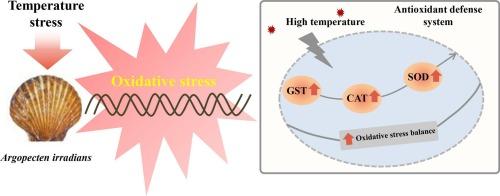温度变化对海湾扇贝(Argopecten irradians)氧化应激和抗氧化防御系统的影响。
IF 2.1
3区 生物学
Q4 BIOCHEMISTRY & MOLECULAR BIOLOGY
Comparative Biochemistry and Physiology A-Molecular & Integrative Physiology
Pub Date : 2024-11-12
DOI:10.1016/j.cbpa.2024.111775
引用次数: 0
摘要
本研究旨在了解温度变化对海湾扇贝(Argopecten irradians)抗氧化防御系统相关生化和分子反应的影响。我们测量了 H2O2 和丙二醛(MDA)的含量、抗氧化酶(如谷胱甘肽 S-转移酶 [GST]、超氧化物歧化酶 [SOD] 和过氧化氢酶 [CAT])的活性以及应激相关基因(如 GST、SOD、CAT 和热休克蛋白 70 [HSP70])的调控。此外,还检测了暴露在不同温度下的扇贝的总抗氧化能力(TAC)。辐照扇贝在急性热应激反应下(暴露 48 和 72 小时)显示出较高水平的 H2O2 和 MDA。温度变化也导致辐照扇贝的抗氧化酶活性和 mRNA 表达水平显著增加。有趣的是,TAC 在急性热应激(28 °C)下最多持续 12 小时,随后下降。高温诱导的氧化应激不能通过提高抗氧化酶(如 GST、SOD 和 CAT)的水平来缓解,从而导致高水平的 H2O2 和 MDA 以及低水平的 TAC。此外,在高温条件下,猕猴桃的抗氧化酶水平也发生了明显变化(P本文章由计算机程序翻译,如有差异,请以英文原文为准。

Influence of temperature changes on oxidative stress and antioxidant defense system in the bay scallop, Argopecten irradians
In this study, we aimed to understand the effects of changes in temperature on biochemical and molecular responses associated with the antioxidant defense system in the bay scallop, Argopecten irradians. We measured the contents of H2O2 and malondialdehyde (MDA), as well as the activities of antioxidant enzymes (e.g., glutathione S-transferase [GST], superoxide dismutase [SOD], and catalase [CAT]), and the regulation of stress-related genes (e.g., GST, SOD, CAT, and heat shock protein 70 [HSP70]). In addition, total antioxidant capacity (TAC) was examined in scallops exposed to different temperatures. A. irradians showed high levels of H2O2 and MDA in response to acute thermal stress (48 and 72 h of exposure). Temperature changes also led to a significant increase in antioxidant enzyme activity and mRNA expression levels in A. irradians. Interestingly, the TAC increased in response to acute thermal stress (28 °C) for up to 12 h and decreased thereafter. The oxidative stress induced by high temperatures could not be alleviated by an increase in levels of antioxidant enzymes, such as GST, SOD, and CAT, resulting in high levels of H2O2 and MDA and low levels of TAC. In addition, significant changes (P < 0.05) in HSP70 levels were observed in response to changes in temperature, suggesting that HSP70 played an important role in the heat tolerance of A. irradians. In conclusion, A. irradians exhibits a greater degree of oxidative stress responses in high-temperature environments than that in low-temperature environments. Overall, these findings indicate that temperature changes lead to oxidative stress, resulting in cellular damage and activation of the antioxidant defense system in bay scallops. Further experiments are required to elucidate other antioxidants and fully understand the redox system in A. irradians.
求助全文
通过发布文献求助,成功后即可免费获取论文全文。
去求助
来源期刊
CiteScore
5.00
自引率
4.30%
发文量
155
审稿时长
3 months
期刊介绍:
Part A: Molecular & Integrative Physiology of Comparative Biochemistry and Physiology. This journal covers molecular, cellular, integrative, and ecological physiology. Topics include bioenergetics, circulation, development, excretion, ion regulation, endocrinology, neurobiology, nutrition, respiration, and thermal biology. Study on regulatory mechanisms at any level of organization such as signal transduction and cellular interaction and control of behavior are also published.

 求助内容:
求助内容: 应助结果提醒方式:
应助结果提醒方式:


